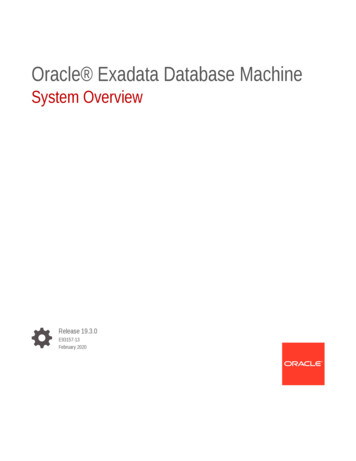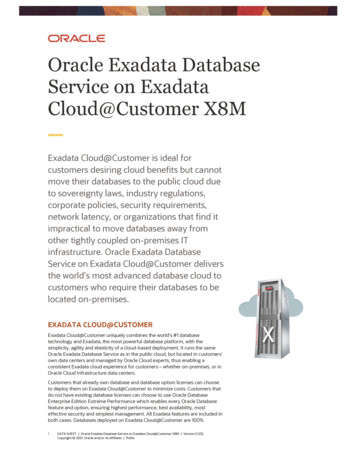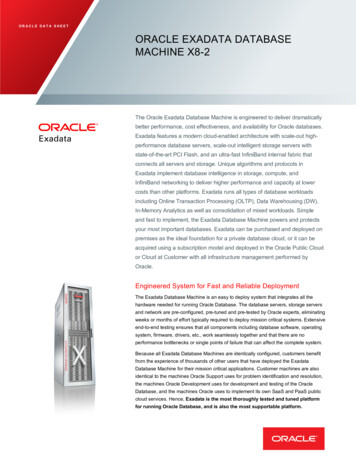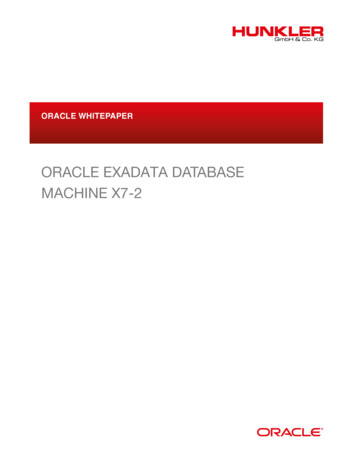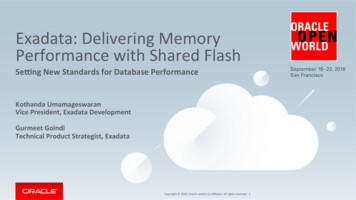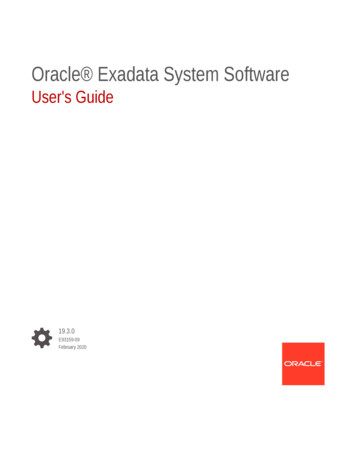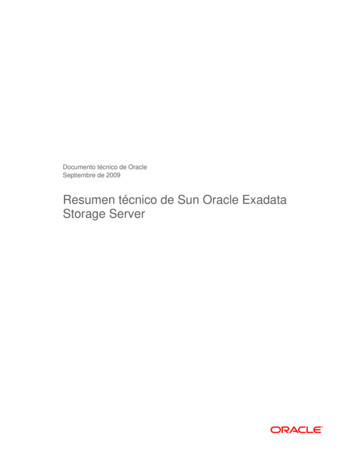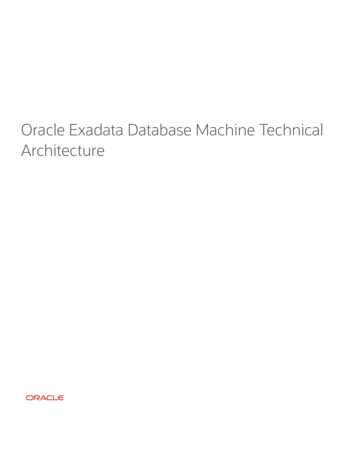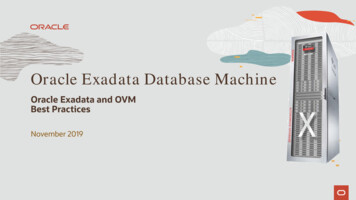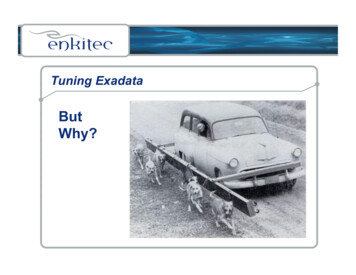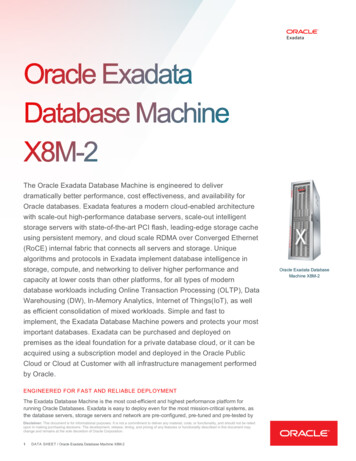
Transcription
The Oracle Exadata Database Machine is engineered to deliverdramatically better performance, cost effectiveness, and availability forOracle databases. Exadata features a modern cloud-enabled architecturewith scale-out high-performance database servers, scale-out intelligentstorage servers with state-of-the-art PCI flash, leading-edge storage cacheusing persistent memory, and cloud scale RDMA over Converged Ethernet(RoCE) internal fabric that connects all servers and storage. Uniquealgorithms and protocols in Exadata implement database intelligence instorage, compute, and networking to deliver higher performance andcapacity at lower costs than other platforms, for all types of moderndatabase workloads including Online Transaction Processing (OLTP), DataWarehousing (DW), In-Memory Analytics, Internet of Things(IoT), as wellas efficient consolidation of mixed workloads. Simple and fast toimplement, the Exadata Database Machine powers and protects your mostimportant databases. Exadata can be purchased and deployed onpremises as the ideal foundation for a private database cloud, or it can beacquired using a subscription model and deployed in the Oracle PublicCloud or Cloud at Customer with all infrastructure management performedby Oracle.ENGINEERED FOR FAST AND RELIABLE DEPLOYMENTThe Exadata Database Machine is the most cost-efficient and highest performance platform forrunning Oracle Databases. Exadata is easy to deploy even for the most mission-critical systems, asthe database servers, storage servers and network are pre-configured, pre-tuned and pre-tested byDisclaimer: This document is for informational purposes. It is not a commitment to deliver any material, code, or functionality, and should not be reliedupon in making purchasing decisions. The development, release, timing, and pricing of any features or functionality described in this document maychange and remains at the sole discretion of Oracle Corporation.1DATA SHEET / Oracle Exadata Database Machine X8M-2Oracle Exadata DatabaseMachine X8M-2
Oracle experts. Extensive end-to-end testing and validation ensures all components includingdatabase software, operating system, firmware, drivers, etc., work seamlessly together and that thereare no performance bottlenecks or single points of failure.Because all Exadata Database Machines are identically configured, customers benefit from theexperience of thousands of other customers’ Exadata Database Machine deployments. Customermachines are also identical to the machines Oracle Support uses for problem identification andresolution, the machines Oracle Development uses for development and testing of the OracleDatabase, and the machines that run Oracle’s own public cloud services. Exadata is the mostthoroughly tested and tuned platform for running Oracle Database.Any application that uses the Oracle Database today can be seamlessly migrated to theExadata Database Machine, with no changes to the application. Likewise, any Oracle Database canalso be easily migrated off Exadata, eliminating “lock-in” concerns.EXTREME SYSTEM SCALABILITY AND GROWTH WITH ELASTIC CONFIGURATIONSThe Exadata Database Machine uses a scale-out architecture for both database servers and storageservers. As workloads grow, database CPUs, storage, and networking can be added to an ExadataDatabase Machine to scale without bottlenecks. The architecture expands from small to extremelylarge configurations to accommodate workloads of any size.A brand new high-bandwidth low-latency 100 Gb/sec RDMA over Converged Ethernet (RoCE)Network Fabric connects all the components inside an Exadata Database Machine. Specializeddatabase networking protocols deliver much lower latency and higher bandwidth than is possible withgeneric communication protocols for faster response time for OLTP operations and higherthroughput for analytic workloads. External connectivity to the Exadata Database Machine is viastandard 10 Gb/sec or 25 Gb/sec Ethernet.Exadata Database Machine is the most versatile database platform. The Exadata X8M-2Database Machine uses powerful database servers, each with two 24-core x86 processors and384 GB of memory (expandable up to 1.5 TB). Exadata also uses scale-out, intelligent storage serversavailable in two configurations – High Capacity (HC) or Extreme Flash (EF). HC Storage Servers havefour NVMe PCI Flash cards each with 6.4 TB (raw) Exadata Smart Flash Cache and twelve 14 TB7,200 RPM disks. EF Storage Servers have an all-flash configuration with eight NVMe PCI Flashdrives, each with 6.4 TB (raw) storage capacity. Exadata X8M HC and EF Storage now includepersistent memory, further boosting capacity and performance. HC and EF Servers receive twelve 128GB Intel Optane DC Persistent Memory modules as a new tier between DRAM and flash. Exadatacombines persistent memory with innovative RDMA algorithms that bypass the network and I/Ostack, eliminating expensive CPU interrupts and context switches, reducing latency by 10x,from 200µs to less than 19µs.The minimal configuration of an Exadata Database Machine consists of two database servers andthree storage servers, which can be expanded into elastic configurations adding more databaseand/or storage servers within the same rack. Elastic configurations provide a flexible and efficientmechanism to meet any size business need.In addition to expanding within a rack, multiple Exadata X8M racks can be connected using theintegrated RoCE network fabric to form even larger configurations. For example, a systemcomposed of four racks is simply four times as powerful as a single rack: it provides four times the I/Othroughput, four times the storage capacity, and four times the processing power. It can be configuredas a single system or logically partitioned for multiple databases. Scaling out is easy, as Oracle Real2DATA SHEET / Oracle Exadata Database Machine X8M-2Key Features Up to 912 CPU cores and28.5 TB memory per rack fordatabase processing Up to 576 CPU cores per rackdedicated to SQL processing instorage Up to 27 TB of PersistentMemory Acceleration per rack 100 Gb/sec RoCE Network Complete redundancy for highavailability From 2 to 19 Database Serversper rack From 3 to 18 Storage Serversper rack Up to 920 TB of flash capacity(raw) per rack Up to 3.0 PB of disk capacity(raw) per rackKey Benefits Pre-configured, pre-testedsystem optimized for alldatabase applications Uncompressed I/O bandwidth ofup to 560 GB/sec per full rackfrom SQL Ability to perform up to 16M 8Kdatabase read I/O operations, or5.1M 8K Flash write I/Ooperations per second in asingle rack Easily add compute or storageservers to meet the needs ofany size application Scale by connecting multipleExadata Database MachineX8M-2 racks or Exadata X8MStorage Expansion Racks. Up to18 racks can be connected bysimply adding RoCE cables andinternal switches. Largerconfigurations can be built withexternal RoCE switches
Application Clusters (RAC) can dynamically add more processing power, and Automatic StorageManagement (ASM) can dynamically add more storage capacity.Related ProductsFigure 1. Elastic Scale-out to Multi-rack ExadataWhen large storage capacity is required, the Oracle Exadata X8M Storage Expansion Rack isavailable. The Exadata Storage Expansion Rack enables customers to grow the storage capacity andcorresponding bandwidth of any Exadata Database Machine. It is designed for database deploymentswith very large amounts of data, including historical or archive data, backups, documents, images,XML, JSON, and LOBs. The storage expansion rack connects to the Exadata Database Machineusing the integrated RoCE network fabric and is configured with a few simple commands, as there areno LUNs or mount points. The starting configuration of the Oracle Exadata Storage Expansion Rackconsists of four storage servers and can be expanded with additional storage servers. Oracle Database Exadata CloudService Oracle Database Exadata Cloudat Customer Oracle Exadata DatabaseMachine X8M-8 Oracle Exadata StorageExpansion Rack X8M-2 Oracle Exadata Storage ServerX8M-2 Plus Network Fabric Oracle Exadata DatabaseServer X8M-2 Plus NetworkFabric Oracle Database 11g, 12c, 18cand 19c Real Application Clusters Partitioning Multitenant Database In-Memory Advanced Compression Advanced Security Active Data Guard GoldenGate Real Application Testing OLAP Advanced Analytics Business Intelligence Enterprise Manager Oracle Linux Oracle Virtual MachineNEW WITH EXADATA X8M: GROUNDBREAKING RDMA BASED NETWORK FABRICThe Exadata X8M release provides the next generation in ultra-fast cloud scale networking fabric,RDMA over Converged Ethernet (RoCE). RDMA (Remote Direct Memory Access) allows onecomputer to directly access data from another without Operating System or CPU involvement, for highbandwidth and low latency. The network card directly reads/writes memory with no extra copying orbuffering and very low latency. RDMA is an integral part of the Exadata high-performance architecture,and has been tuned and enhanced over the past decade, underpinning several Exadata-onlytechnologies such as Exafusion Direct-to-Wire Protocol and Smart Fusion Block Transfer. As theRoCE API infrastructure is identical to InfiniBand’s, all existing Exadata performance features areavailable on RoCE.The Exadata X8M release implements 100 Gb/sec RoCE network fabric, making the world’s fastestdatabase machine even faster. Real world database workloads running on Exadata X8M, deployedwith the new shared persistent memory accelerator, have smashed the previous benchmark of6.7M Read IOPS, set by Exadata X8, with over 16 Million Read OLTP Read IOPS (8K IOs).3DATA SHEET / Oracle Exadata Database Machine X8M-2Related ServicesThe following services areavailable from Oracle: Advanced Customer Services Oracle Premier Support forSystems Oracle Platinum Services Oracle Consulting Services Oracle University courses
NEW WITH EXADATA X8M: SHARED PERSISTENT MEMORY ACCELERATIONNew with Exadata X8M, storage servers include persistent memory (PMEM) data and commitaccelerators in front of flash cache, enabling orders of magnitude lower latency accessing remotelystored data. Persistent memory is a new silicon technology, adding a distinct storage tier ofperformance, capacity, and price between DRAM and Flash. As the persistent memory is physicallypresent on the memory bus of the storage server, reads perform at memory speed, much faster thanflash. Writes are persistent, surviving power cycles, unlike DRAM. By utilizing RDMA to accesspersistent memory remotely, Exadata Smart PMEM Cache is able to bypass the network, I/Osoftware, interrupts and context switches, achieving more than 10x lower latency than previousExadata generations, down to less than 19 microseconds. Smart Exadata System Software alsoensures data is mirrored across storage servers, which provides additional fault-tolerance. Exadata’sunique end-to-end integration between Oracle Database and Exadata Storage automatically identifiesthe hottest data blocks to store, while ensuring database, persistent memory, and flash cache do nothold the same block multiple times, increasing the efficiency across the storage tiers. Addingpersistent memory to the storage tier means the aggregate performance of this new cache tier can bedynamically used by any database on any server. This is a significant advantage over general-purposestorage architectures, which preclude sharing across servers.Another smart new Exadata System Software feature boosts log write performance. Log write latencyis critical for OLTP performance, a faster log write means faster commit times. Inversely, anyslowdown of log writes can cause the database to stall. Unique to Exadata X8M, Exadata SmartPMEM Log automatically enables the database to issue a one-way RDMA log write to persistentmemory. RDMA and persistent memory technologies allow the log write to occur withoutacknowledgement, and smart software places the write across multiple servers for resilience. Thisleads to an 8x performance increase in log writes.Security and management of this new tier are also automated. Persistent memory is configuredautomatically at installation time, with no user interaction required. Hardware monitoring is configuredout of the box. Persistent memory is only accessible to databases using database access controls,ensuring end to end security of data. Deploying persistent memory in Exadata X8M is so simple, it’stransparent.“I would recommend Exadataas a platform for performance,reliability and ease of support.Those three things mean verymuch to me in my daily life.”Richard EwaldSenior Technical ArchitectSprint“Oracle Exadata enabledseamless and rapid migrationof our cloud-based, integratedbusiness applications, requiredno major modifications, andhelped us reduce costs. WithOracle, we dramaticallyimproved our batch processingspeed by 241x and overallsystem performance by 3x,enabling us to improveoperating efficiency for ourdaily, critical tasks and toenhance customer service.”Kyoji KatoExecutive Officer and GMDaiwa HouseFigure 2. Intel Optane DC Persistent Memory modulesEXTREME FLASH STORAGE SERVER: RECORD-BREAKING I/O PERFORMANCEExadata Extreme Flash (EF) Storage Server, first introduced with Exadata X5, is the foundation of adatabase-optimized all-flash Exadata Database Machine. Each EF Storage Server contains eight 6.4TB Flash Accelerator F640v2 NVMe PCI Flash drives, offering 51.2 TB raw flash capacity per EFStorage Server. This state-of-the-art flash memory improves speed and power efficiency, and providesan expected endurance of 8 years or more for typical database workloads. In addition, Exadatadelivers ultra-high performance by placing these flash devices directly on the high speed PCI busrather than behind slow disk controllers and directors. Exadata X8M adds the shared persistent4DATA SHEET / Oracle Exadata Database Machine X8M-2
memory acceleration tier, twelve 128 GB Intel Optane DC Persistent Memory modules in front offlash to boost performance even more.Exadata X8M uses a combination of scale-out storage, RDMA over Converged Ethernet networking,database offload, persistent memory accelerator and PCI Flash to deliver extremely high performancefrom memory and flash. A single rack configuration of Exadata Database Machine X8M-2, with 11database servers and 11 Extreme Flash storage servers, using the new persistent memoryaccelerator, can achieve up to 16 Million random 8K database read and 5.17 Million random 8Kflash write I/O operations per second (IOPS), which is an industry record for database workloads.These are real-world end-to-end performance figures measured running SQL workloads with standard8K database I/O sizes inside a single rack Exadata system, unlike storage vendor performance figuresbased on small I/O sizes and low-level I/O tools and are therefore many times higher than can beachieved from realistic SQL workloads. Exadata’s performance on real database workloads is ordersof magnitude faster than traditional storage array architectures, and is also much faster than currentall-flash storage arrays, whose architecture bottlenecks flash throughput.Figure 3. Flash Accelerator PCIe CardHIGH CAPACITY STORAGE SERVER: TIERED DISK FLASH AND PERSISTENTMEMORY DELIVER COST OF DISK WITH SHARED MEMORY PERFORMANCEThe second Exadata storage option is the High Capacity (HC) Storage Server. This server includestwelve 14 TB SAS disk drives with 168 TB total raw disk capacity. It also has four Flash AcceleratorF640v2 NVMe PCIe cards with a total raw capacity of 25.6 TB of flash memory. Exadata X8M addsthe shared persistent memory acceleration tier, twelve 128 GB Intel Optane DC PersistentMemory modules in front of flash to boost performance even more. Deployed using smart software,Exadata Smart PMEM Cache, only the hottest database blocks are automatically cached in this newtier. Accessible over RDMA direct from the database delivers the highest I/O rates at an extremely lowlatency.Flash in the HC Storage Server can be used directly as flash disks, but is almost always configured asa flash cache (Exadata Smart Flash Cache) in front of disk storage behind the PMEM Cache todeliver the best performance. Exadata Smart Flash Cache is used in-sync with PMEM Cache toautomatically cache frequently accessed data while keeping infrequently accessed data on disk,delivering the high I/O rates and fast response times of flash with the large capacity and low cost ofdisk. Exadata uniquely understands database workloads and knows when to avoid caching datathat will negatively affect overall performance. For example, if large write I/Os caused by backupsor large table scans are likely to disrupt higher priority OLTP or scan operations, those large I/Os willbypass the flash cache and go straight to disk. Otherwise, Exadata System Software will utilizeadditional spare flash capacity and I/O bandwidth to optimize performance by caching these I/Os. Inaddition to automatic caching, administrators can optionally provide SQL directives to ensure thatspecific tables, indexes, or partitions are preferentially retained in the flash cache.It is common for hit rates in the Exadata Smart Flash Cache to be over 95%, or even 99% in real-worlddatabase workloads, yielding an effective flash capacity many times larger than the physical flash. For5DATA SHEET / Oracle Exadata Database Machine X8M-2“Oracle Exadata DatabaseMachine is helping to transformour business. Our SAPenvironment, one of the world’slargest, can now support twiceas much throughput withimproved stability.”Milt SimondsDirector, Enterprise PlatformDeliveryAmerisourceBergen Corporation
example, a traditional full rack, with 8 database servers and 14 High Capacity Storage Servers oftenhas an effective flash capacity close to the usable disk capacity of 700 TB.The Exadata Smart Flash Cache also caches database block writes using Exadata Write Back FlashCache technology. Write caching eliminates disk bottlenecks in large scale OLTP and batchworkloads. The flash write capacity of a single full rack Exadata Database Machine X8M-2 with 8database servers and 14 High Capacity Storage Servers exceeds 6.5 Million 8K flash write I/Ooperations per second (IOPS). The Exadata write cache is transparent, persistent, and fullyredundant, with performance comparable to dozens of enterprise disk arrays with thousands of diskdrives.The automatic data tiering between RAM, persistent memory, flash and disk in Exadata providestremendous advantages over other flash-based solutions. Many storage vendors have developedflash-only arrays to achieve higher performance than traditional arrays. These flash-only arrays deliverbetter performance but cannot match the cost advantages of Exadata’s smart tiering of data betweendisk and flash, as the overall size of data that can benefit from flash is limited to the size of expensiveflash. And these flash arrays are unable to benefit from Exadata’s unique database-aware storageoptimization technologies. Generic data deduplication provided by some flash arrays is effective forVirtual Desktop Infrastructure environments, but not for databases.Exadata not only delivers much more capacity than generic all-flash arrays, it also delivers betterperformance. Flash-only storage arrays cannot match the throughput of Exadata's integrated andoptimized architecture with full 100 Gb/sec RDMA over converged ethernet based scale-out network,fast PCI Flash, offload of data intensive operations to storage, and algorithms throughout that arespecifically optimized for databases.EXTENDED CAPACITY STORAGE SERVER: MUCH LOWER COST EXADATA STORAGEFOR LOW USE DATAA third Exadata storage option was introduced with Exadata X8 - the Extended (XT) Storage Server.Each Exadata XT Storage Server includes twelve 14 TB SAS disk drives with 168 TB total raw diskcapacity. To achieve a lower cost, flash is not included, and storage software is optional in this storageserver. For the X8M generation, the XT Extended Storage server benefits from the addition of 100Gb/snetwork.This storage option extends the operational and management benefits of Exadata to rarely accesseddata that must be kept online. Exadata’s Extended (XT) Storage Server is: Efficient – The XT server offers the same high capacity as the HC Storage server, includingHybrid Columnar CompressionSimple – The XT server adds capacity to Exadata while remaining transparent toapplications, transparent to SQL, and retains the same operational modelSecure – The XT server enables customers to extend to low-use data the same Exadatasecurity model and encryption used for online dataFast and Scalable – Unlike other low-use data storage solutions, the XT server is integratedto the Exadata fabric, for fast access and easy scale-outCompatible – The XT server is just another flavor of Exadata Storage server – you can justadd XT servers to any Exadata rackWith Exadata Extended (XT) Storage Server, enterprises can meet their long-term data retentioncompliance requirements with the same trusted and continually validated Exadata solution, avoidingthe operational risks and costs of managing information lifecycle across multiple platforms.6DATA SHEET / Oracle Exadata Database Machine X8M-2“We chose Oracle Exadatabecause it offered a completesolution . we’ve created dailyfinancial reports 4x faster andliquidity risk reports 7x fasterto consistently meet ourservice-level agreement,improved credit riskmanagement, and reduced ourdata center footprint.”Vaibhav SamantSenior Vice President, ITHDFC Bank Ltd.
ACCELERATING DATABASE PROCESSING WITH SMART SYSTEM SOFTWAREAs data volumes continue their fast growth, conventional storage arrays struggle to quickly transferdata from disk and flash to database servers at a rate that keeps the CPUs busy. Modern servers withdozens of CPU cores can consume data at many tens to hundreds of gigabytes a second. This is farfaster than conventional storage arrays can deliver data through their storage controllers and thestorage network.Exadata System Software enables Exadata’s unparalleled performance without any of thebottlenecks of traditional storage, by implementing a unique highly efficient database-optimizedstorage infrastructure on the Exadata Storage Server. Each Exadata Storage Server has two 16-corex86 processors that are used to offload database processing, and a rack of Exadata DatabaseMachine can have a total of up to 576 processor cores in the storage servers able to offload thedatabase servers. The CPUs in the storage servers do not replace database CPUs. Instead theyaccelerate database intensive workloads similar to how graphics cards accelerate image intensiveworkloads.“The heart and soul of ourstack right now is OracleExadata Database Machine.With Oracle Exadata, we’vebeen able to reduce queriesfrom days to minutes, andthose that used to take minutesto seconds.”Chris WonesEnterprise ArchitectDunnhumbyOne of the many unique features of Exadata System software is Smart Scan technology, whichoffloads data intensive SQL operations from the database servers directly into the storageservers. By pushing SQL processing to the storage servers, data filtering and processing occurimmediately and in parallel across all storage servers, as data is read from disk and flash. Only therows and columns that are directly relevant to a query are sent to the database servers.For example, if a query is executed to identify the customers who placed sales orders over 1000 inthe month of March, an Exadata system will offload the scanning of the table to the Exadata storage,filter out all sales orders that are less than 1000, filter out sales orders not in March, and extract justthe relevant customer information. This reduces the data transferred to the database servers by ordersof magnitude. Smart Scan greatly accelerates query execution, eliminates bottlenecks, andsignificantly reduces the CPU usage of the database servers.Storage Index is another powerful unique capability of Oracle Exadata System software that helpsavoid unnecessary I/O operations and improves overall performance. The storage index, maintainedin-memory at the storage server, tracks summary information for table columns contained in a storageregion on that storage server. When a query specifies a WHERE clause, Exadata System softwareexamines the storage index using a Bloom filter to determine if rows with the specified column valuemight exist in a region of disk on the storage server. If the column value doesn’t exist in the Bloomfilter, then scan I/O in that region for that query is skipped. Storage Indexes make many SQLoperations run dramatically faster because large numbers of I/O operations are automatically replacedby a few in-memory lookups.Besides the intrinsic capabilities of Exadata System software, the combination of Oracle Databasesoftware, Exadata System software and Exadata infrastructure enables several additional uniquecapabilities that offer unparalleled performance levels for OLTP workloads. For example, ExafusionDirect-to-Wire Protocol uniquely allows database processes to read and send Oracle RealApplications Cluster (Oracle RAC) messages directly over the ultra-fast RoCE network using RemoteDirect Memory Access (RDMA), bypassing the OS kernel and networking software overhead. Thisimproves the response time and scalability of Oracle RAC OLTP configurations on Oracle ExadataDatabase Machine, especially for workloads with high-contention updates.In some OLTP workloads, more than half of remote reads are for Undo Blocks to satisfy readconsistency. Exadata uniquely leverages ultra-fast RDMA to read UNDO blocks from other databaseinstances, further improving OLTP performance.7DATA SHEET / Oracle Exadata Database Machine X8M-2“[With Exadata] We can morequickly process 65 billion dailytransactions for data charging,while providing real-timeinformation for customerinquiries, increasing customersatisfaction, and reducingcosts.”Jin Hyung LeeICT Team Manager, NetworkingEngineeringSK Telecom
The Smart Fusion Block Transfer capability uniquely improves performance of a RAC OLTPconfiguration further by eliminating the impact of redo log write latency, especially when hot blocksneed to be transferred between sending and receiving nodes. The block is transferred as soon as theI/O to the redo log is issued at the sending node, without waiting for it to complete. Oracle internaltests show that Smart Block Transfer increases throughput (about 40% higher) and decreasesresponse times (about 33% less) for communication-intensive workloads.To further accelerate OLTP workloads, new with Exadata X8M High Capacity and Extreme FastStorage Servers, a Persistent Memory Commit Accelerator is added, enabling the database to performlog writes via RDMA direct to the persistent memory buffer of multiple storage servers in parallel.Deployed as Exadata Smart PMEM Log, it avoids interaction with the Operating System and theoverhead of transferring data via the standard I/O path. This one-way transaction increasesperformance of log writes by up to 8 times.“Exadata is the heart of thebooking engine, and we cannotoperate as a business, wecannot sell tickets without it.”James CallaghanChief TechnologistWestjetIn addition, Exadata uniquely uses Machine Learning to implement Automatic Indexing with OracleDatabase 19c. Automatic Indexing continually analyzes executing SQL and creates new indexes toaccelerate performance. Automatic Indexing continuously learns and tunes the database as theunderlying data model or usage patterns change.Exadata also uniquely implements Real Time Statistics gathering as DML operations insert, updateor delete data. Real Time Statistics allows the SQL optimizer to adapt plans dynamically as thedistribution of data changes.OPTIMIZING STORAGE USE AND I/O THROUGH COMPRESSIONThe Exadata Storage Server provides a unique compression capability called Hybrid ColumnarCompression (HCC) that enables dramatic reductions in storage for large databases. HybridColumnar Compression technology is an innovative method of organizing data within a database tablethat uses a combination of both row and columnar methods for storing data. This hybrid approachachieves the compression benefits of columnar storage, while avoiding the performance shortfalls of apure columnar format.With Hybrid Columnar Compression, Exadata enables the highest levels of data compression possiblewith Oracle databases, and provides substantial cost-savings and performance improvements due toreduced I/O, especially for analytic workloads. Storage savings is data-dependent and often rangesfrom 5x to 20x. Average storage savings is an industry-leading 10x. On conventional systems,enabling high data compression has the drawback of reducing performance as it adds the load ofdecompression to the CPU. Because the Exadata Database Machine is able to offload decompressionto processors in Exadata storage, and in addition there is reduced I/O need because of the highcompression achieved, most analytic workloads run faster using Hybrid Columnar Compression thanwithout it.Two modes of Hybrid Columnar Compression are available. Warehouse compression mode issuitable for read-intensive workloads and provides large storage savings and enhanced analyticperformance. Archive compression mode provides the highest degree of compression and istargeted at data that is seldom accessed but still must be kept online. In addition, this data can now beseamlessly stored on the XT storage server for further cost reduction.On OLTP systems, Hybrid Columnar Compression can be used to compress older, less active datawhile newer, more active and update-intensive data can be compressed using Advanced RowCompression. Oracle Database Release 18c and above provides the ability to change the type ofcompression used by individual table partitions online (even if there are global indexes on the tabl
Application Clusters (RAC) can dynamically add more processing power, and Aut omatic Storage Management (ASM) can dynamically add more storage capacity. Figure 1. Elastic Scale-out to Multi-rack Exadata . When large storage capacity is required, the . Oracle Exadata X8M Storage Expansion Rack . is available.
